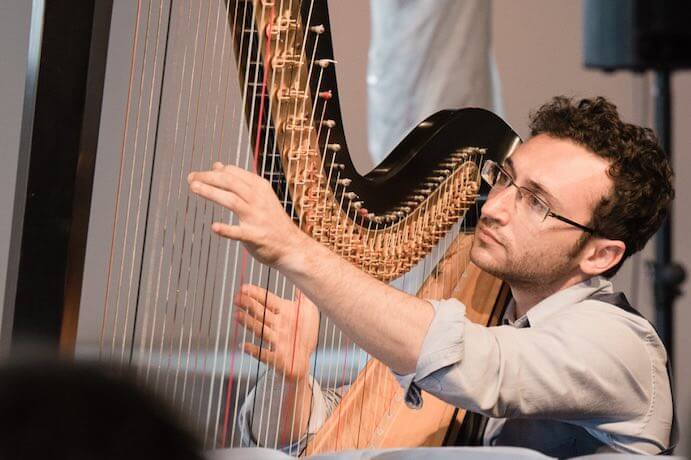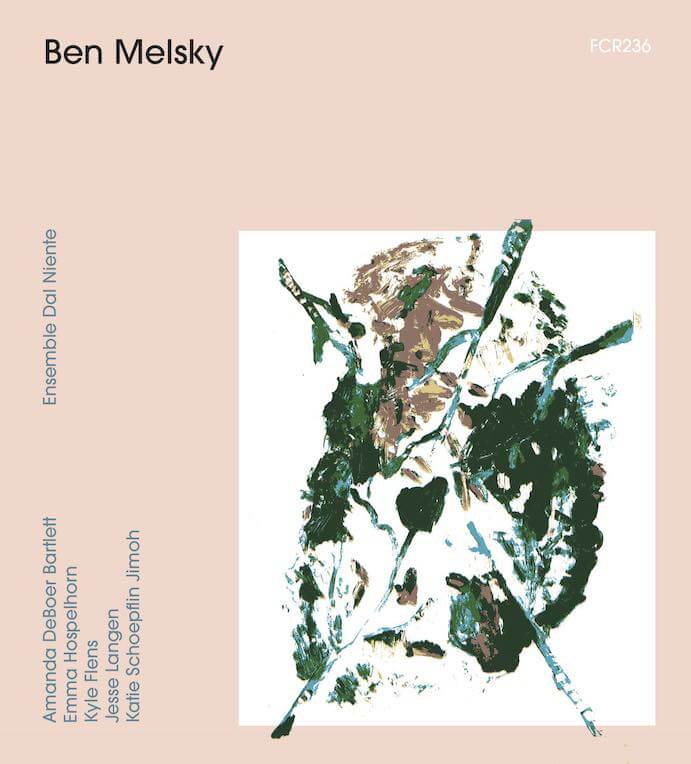The harp glissando: it’s a recognizable gesture, one that listeners might associate with cinematic depictions of high society, dream sequences, or the heavens. Not only is it recognizable, it’s everywhere, and that saturation often places the harp in the realm of the cliché. One would think that an album of harp music intending to break from tradition would avoid the prominent use of glissandi, but in New Works for Harp (New Focus Recordings), Ben Melsky of Ensemble Dal Niente opens with this gesture – and absolutely pulls it off.
Tomás Gueglio’s After L’Addio (referencing Sciarrino’s L’Addio a Trachis for solo harp) sets the tone for Melsky’s sonic exploration of the instrument by immediately obscuring the iconic glissando gesture. The piece combines the traditional glissando with sharp plucking, harmonics, bisbigliandi, and the “Guegliando” (devised by Melsky and Gueglio, a glissando with calloused fingertips and strong pressure, creating a dry sound). The significant time spent in collaboration between composer and performer pays off–Gueglio’s timbral language is immediately captivating, and Melsky performs with impeccable fluidity. Following After L’Addio is its sister piece Felt, which starkly contrasts the bombast of glissandi and glissando-like figures with introverted gestures combining harmonics and a felt pick. Despite the seeming simplicity of this piece, the techniques are incredibly virtuosic, requiring precise finger placement to get the right clash or consonance of overtones against equal-tempered plucking. Melsky’s command of emotional contrast is stunning.

Ben Melsky–Photo by Aleks Karjaka
The effective construction of New Works for Harp doesn’t end with its firm opening statement. After demonstrating the harp’s expressive and experimental potential as a solo instrument, Melsky showcases some of the instrument’s best natural synergies in a series of duets. Alican Çamci’s Perde is an excellent example of synergistic timbral exploration. Organized around Çamci’s transcription of a ‘Masnavi’ (a 15th-century Sufi poetic form), the speech-like piece is realized to great effect through corresponding extended techniques and composite and unison rhythmic motion between flute and harp. Çamci’s further complements this pairing echoing the flute sounds with the natural resonance of the harp. The lower flute sounds when paired with harp harmonics lead to some tuning issues, but overall, the empathetic timbral shifts offer several sublime moments.
Fredrick Gifford’s Mobile 2015: Satirise provides a different perspective on the timbral profile of the harp by pairing it with a similar instrument: the guitar. The pairing is just homogenous enough to create granular shifts in color, emphasized by the detuning of the guitar and the open form encouraging conversational interplay between Melsky and guitarist Jesse Langen. Mobile 2015: Satirise is subtly humorous, and provides a nice palate cleanser for the middle of the album. Following the timbral similarity of the Gifford, Wang Lu’s After some remarks by CW on his work is pleasantly striking in its exploration of opposites. Earthy clarinet multiphonics open the piece accompanied by the ethereal texture of low clusters and resonant harmonics in the harp. The exploration of glissando returns in this track, and Wang Lu’s use of detuning perfectly balances familiarity and variety with goosebump-inducing effectiveness.

Wang Lu–Photo courtesy www.wanglucomposer.com
Igor Santos takes the listener about as far away from conventional harp music as one can get by exploring its vast, often untapped percussive potential. His work Anima pairs harmonics, muted plucking, and striking of the soundboard with several percussion implements and vocal sounds. The piece is highly episodic without sacrificing a clear trajectory, interrupting directional development with timbral studies of the space between previously dissimilar textures. Santos, Melsky, and percussionist Kyle Flens exemplify the sensitivity to tone color and atypical musical expression which have placed Ensemble Dal Niente (and the composers with whom they collaborate) among the best contemporary ensembles in the world.
Eliza Brown’s On-dit serves as an exquisite ending to this album. While many of the previous selections are captivating through their sonic density, Brown maintains the listener’s attention through her adept display of patience with the musical material. On-dit washes over the listener with infinitesimal shifts between breathy, dry gestures and fully intoned ones, a sound world perfectly suited to soprano Amanda DeBoer Bartlett’s voice. In fact, it is DeBoer Bartlett’s chameleonic interplay with the harp that makes this performance truly special, creating such smooth sonic development that the sparse interruptions of material become particularly impactful.
Considering the album as a whole, the reinvention of the harp glissando at the beginning feels even more appropriate. In New Works for Harp, Ben Melsky wordlessly argues the flexibility and expressivity of the harp, first by directly confronting the instrument’s historical convention, then by comprehensively demonstrating its often-untapped capacities. New Works for Harp is simultaneously an outstanding academic source for the harp and an emotional voyage for the casual listener.



















